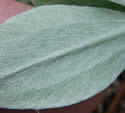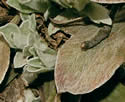Antennaria parlinii (Parlin's Pussytoes)
| Also known as: | Smooth Pussytoes |
|---|---|
| Genus: | Antennaria |
| Family: | Asteraceae (Aster) |
| Life cycle: | perennial |
| Origin: | native |
| Habitat: | sun; dry; prairies, roadsides, open woods, rock outcrops, grassy banks, wooded slopes |
| Bloom season: | April - June |
| Plant height: | 6 to 16 inches |
| Wetland Indicator Status: | none |
| MN county distribution (click map to enlarge): |  |
| National distribution (click map to enlarge): |  |
Pick an image for a larger view. See the glossary for icon descriptions.
Detailed Information
Flower: 


![[photo of female flowers]](/udata/r9ndp23q/white/antennaria-parlinii-parlins-pussytoes_0606_065014-t.jpg) Four to 12+ flower heads in a flat to rounded cluster at the top of the stem, with separate male and female flowers on separate plants. Female flower heads are 1/3 to ¾ inch long and look like little shaving brushes, with numerous thread-like styles at the top and the head surrounded by a series of bracts (called phyllaries), each phyllary green and firm (somewhat leaf-like) at the base and thin and white (more petal-like) at the tip. Individual flowers are 4 to 7 mm (to .28 inch) long and the set of phyllaries (called the involucre) is 7 to 13 mm (max .5 inch) long at maturity.
Four to 12+ flower heads in a flat to rounded cluster at the top of the stem, with separate male and female flowers on separate plants. Female flower heads are 1/3 to ¾ inch long and look like little shaving brushes, with numerous thread-like styles at the top and the head surrounded by a series of bracts (called phyllaries), each phyllary green and firm (somewhat leaf-like) at the base and thin and white (more petal-like) at the tip. Individual flowers are 4 to 7 mm (to .28 inch) long and the set of phyllaries (called the involucre) is 7 to 13 mm (max .5 inch) long at maturity.
![[photo of male flowers]](/udata/r9ndp23q/pd/antennaria-parlinii-050609-t.jpg) The male flowers are less furry looking, in rounded heads with scaly white flowers that have a brown column of stamens protruding from the center. The involucre on male flower heads is 6 to 9 mm long with individual flowers 3.5 to 5 mm long.
The male flowers are less furry looking, in rounded heads with scaly white flowers that have a brown column of stamens protruding from the center. The involucre on male flower heads is 6 to 9 mm long with individual flowers 3.5 to 5 mm long.
Leaves and stems: 


![[photo of basal leaves]](/udata/r9ndp23q/white/antennaria-parlinii-parlins-pussytoes-100_8308-t.jpg) Leaves are basal and alternate. Basal leaves are 1 to 3¾ inches long and up to 1¾ inches wide, toothless, broadly spoon or spatula-shaped, rounded at the tip, tapering to a winged stalk, and with 3 to 5 prominent veins that are most easily seen on the back of the leaf. The lower surface is silvery white from dense matted hairs, the upper surface green to gray-green, hairless to woolly hairy or initially moderately hairy becoming hairless. Basal leaves tend to persist to the next season before shriveling up and disintegrating.
Leaves are basal and alternate. Basal leaves are 1 to 3¾ inches long and up to 1¾ inches wide, toothless, broadly spoon or spatula-shaped, rounded at the tip, tapering to a winged stalk, and with 3 to 5 prominent veins that are most easily seen on the back of the leaf. The lower surface is silvery white from dense matted hairs, the upper surface green to gray-green, hairless to woolly hairy or initially moderately hairy becoming hairless. Basal leaves tend to persist to the next season before shriveling up and disintegrating.
![[photo of stem leaves]](/udata/r9ndp23q/pd/antennaria-parlinii-6020086-26-t.jpg) Stem leaves are lance-oblong, up to 1¾ inches long and about ¼ inch wide, toothless, stalkless, woolly hairy, and widely spaced along the stem. Stems are erect, green to reddish, covered in long, white, matted hairs, sometimes glandular hairy on the upper stem. Horizontal, above ground stems (stolons) emerge from basal leaf clumps, spreading in all directions, prostrate but rising at the tips (decumbent), rooting at the nodes and forming colonies. Colonies of male plants tend to be separate from females and may be close by or absent altogether.
Stem leaves are lance-oblong, up to 1¾ inches long and about ¼ inch wide, toothless, stalkless, woolly hairy, and widely spaced along the stem. Stems are erect, green to reddish, covered in long, white, matted hairs, sometimes glandular hairy on the upper stem. Horizontal, above ground stems (stolons) emerge from basal leaf clumps, spreading in all directions, prostrate but rising at the tips (decumbent), rooting at the nodes and forming colonies. Colonies of male plants tend to be separate from females and may be close by or absent altogether.
Fruit: 
![[photo of fruit]](/udata/r9ndp23q/pd/antennaria-parlinii-060814-5-t.jpg) Fruit is a brown seed 1 to 2 mm long with a tuft of white hair (pappus) attached to carry it off in the wind. Hairs are 5 to 8 mm long.
Fruit is a brown seed 1 to 2 mm long with a tuft of white hair (pappus) attached to carry it off in the wind. Hairs are 5 to 8 mm long.
Notes:
There are 6 species of Pussytoes in Minnesota and they are a tough group, but generally put into two categories: those with a single prominent vein on basal leaves (most easily seen on the back of a mature leaf), and those with 3 (or more) prominent veins. Note that early leaves even on some 1-veined species may have faint lateral veins which can make identification questionable, in which case examining any old basal leaves persisting from the previous season might help make a more confident determination.
There are 2 subspecies of Antennaria parlinii, both of which have been found in Minnesota: subsp. parlinii, recorded only once in the St. Croix River Valley but fairly common in the southern half of Wisconsin, has basal leaves mostly hairless on the upper surface, and has purple glandular hairs on the upper stem; subsp. fallax, widespread in the state, has no glandular hairs, and basal leaves are more moderately hairy on the upper surface though may become hairless with age.
In the case of 3-veined Pussytoes species, in Minnesota this trait is shared only between Parlin's Pussytoes and Plantain-leaved Pussytoes (Antennaria plantaginifolia) and the two are similar in most other respects as well, which makes them easily confused. It doesn't help that these two species were considered vars of a single species for a time. That fact is evident in the Bell Herbarium records as well—the current records put both species widespread in the state when more recent research limits A. plantaginifolia to the driftless area in our southeast counties. This won't be corrected until some adventurous soul examines all of the old specimens and makes changes accordingly, but most of the old A. plantaginifolia records should become A. parlinii.
Besides the location within or outside the driftless area, the most notable differences between A. plantaginifolia and A. parlinii are in the flower sizes and hairiness of basal leaves. The leaf difference is the more subtle distinction, with the upper surface of A. plantaginifolia usually more woolly and gray-green where A. parlinii is often (not always) more green, sometimes hairless (subsp. parlinii) or initially hairy and may become hairless with age (subsp. fallax). Flower and fruit sizes are a more consistent difference, with all parts of A. plantaginifolia smaller than A. parlinii—female involucre 5 to 7 mm (max .28 inch) vs. 7 to 13 mm (max .5 inch), seeds .5 to 1.6 mm vs. 1 to 2 mm, pappus 3.5 to 5.5 mm vs. 5 to 8 mm. A metric ruler may be helpful. Also, A. plantaginifolia male plants are almost always present where A. parlinii males may or may not.
Native Plant Nurseries, Restoration and Landscaping Services ↓
More photos
 Parlin's Pussytoes plants
Parlin's Pussytoes plants Parlin's Pussytoes plants
Parlin's Pussytoes plants Parlin's Pussytoes plants
Parlin's Pussytoes plants Parlin's Pussytoes plants
Parlin's Pussytoes plants a small colony in fruit
a small colony in fruit stolons are horizontal but rising at the tip (decumbent)
stolons are horizontal but rising at the tip (decumbent) more basal leaf clumps
more basal leaf clumps young leaves may have faint lateral veins (look for mature leaves)
young leaves may have faint lateral veins (look for mature leaves) emerging among old basal leaf clumps in early spring
emerging among old basal leaf clumps in early spring hairs on upper surface of a basal leaf
hairs on upper surface of a basal leaf host plant for American Painted Lady butterflies
host plant for American Painted Lady butterflies comparison of Antennaria parlinii and A. plantaginifolia flower heads
comparison of Antennaria parlinii and A. plantaginifolia flower heads
Photos by K. Chayka taken in Carlton, Chisago, and Ramsey counties. Photos by Peter M. Dziuk taken in Anoka, Beltrami, Dakota and Ottertail counties.
Comments
Have you seen this plant in Minnesota, or have any other comments about it?
on: 2024-02-01 16:38:36
These grow near the ditch where I live. I had them ID'd as downy Parlin's pussytoes. Not sure if that's different from above.
on: 2024-02-01 16:57:56
luciearl, there is no standardization where it comes to common names of plants, so Latin really is the way to go when looking up info on any species.






